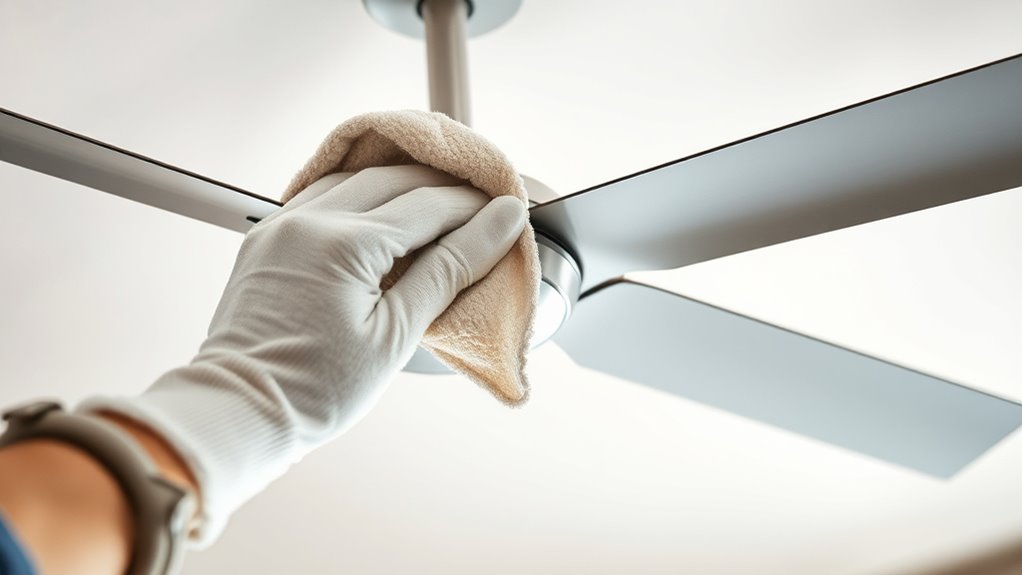To clean a ceiling fan without dust fallout, start by turning off the fan and ensuring the blades are stationary. Use an extendable microfiber duster or damp microfiber cloth to wipe each blade from the center to the edge, keeping dust contained. For stubborn spots, gently wipe with a soap-dampened cloth followed by a clean damp cloth. Regular maintenance and careful cleaning techniques help prevent dust dispersal—continue exploring how to keep your fan spotless and dust-free effortlessly.
Key Takeaways
- Lay a drop cloth or old sheet beneath the fan to catch falling dust during cleaning.
- Use a microfiber cloth or extendable duster slightly dampened to trap dust effectively.
- Wipe blades from the center to the edge with gentle pressure to minimize dust dislodgment.
- Clean blades in sections, working carefully to prevent dust from scattering into the air.
- Turn off the fan and spin blades by hand afterward to verify smooth operation and reduce residual dust.

Cleaning a ceiling fan might not be at the top of your list, but keeping it tidy is essential for good air quality and efficient operation. Over time, dust and grime accumulate on the blades, which can reduce airflow and circulate allergens. To prevent this buildup, you need to focus on fan blade maintenance. Start by turning off the fan and ensuring the blades are completely stationary. Use a sturdy step ladder or a stable chair to reach the blades safely. Before you begin cleaning, lay down a drop cloth or old sheet beneath the fan to catch any falling dust or debris. This simple step minimizes mess and makes cleanup easier.
Next, it’s time to tackle dust removal techniques. The key is to remove dust without spreading it everywhere. One effective method is to use a microfiber cloth or a damp rag. If you prefer, an extendable duster with a microfiber head works well for reaching all areas of the blades. Lightly dampen the cloth or duster to help trap dust rather than just pushing it around. Wipe each blade carefully, following the length from the center to the edge. Apply gentle pressure to lift dust off the surface without bending or damaging the blades. If you notice stubborn spots or greasy buildup, mix a small amount of mild dish soap with water. Dampen a cloth with this solution and gently wipe the blades, then follow up with a clean, damp cloth to remove any soap residue.
For thorough fan blade maintenance, don’t forget to clean the motor housing and the mounting bracket. Use a dry cloth or a vacuum with a brush attachment to remove dust from these areas. Avoid using excess water or harsh chemicals on electrical components. Once you’ve completed dust removal, it’s a good idea to check the fan’s blades for any signs of damage or warping. If you spot any issues, consider replacing or repairing the blades to keep your fan functioning smoothly. Regular home cleaning and maintenance help prevent the buildup of dust and prolong the life of your appliances.
Finally, after cleaning, spin the blades by hand to ensure they move freely and are properly aligned. Turn the fan back on and observe for any unusual noises or vibrations. Regularly scheduled maintenance, including dust removal techniques and fan blade upkeep, will keep your ceiling fan running efficiently and improve your indoor air quality. With just a little effort, you’ll enjoy a cleaner, fresher home environment free of dust fallout.
Frequently Asked Questions
How Often Should I Clean My Ceiling Fan to Prevent Dust Buildup?
You should clean your ceiling fan every 1 to 2 months to prevent dust buildup. Regular fan maintenance helps keep dust prevention manageable and reduces allergens circulating in your home. By staying consistent with cleaning, you’ll avoid the heavy dust fallout that can occur if you neglect your fan for too long. A quick wipe down during your routine cleaning will keep your fan functioning smoothly and improve indoor air quality.
Can I Use a Vacuum Cleaner to Clean Ceiling Fan Blades?
Think of your vacuum cleaner as a trusty sidekick for fan blade maintenance. Yes, you can use it, but prioritize vacuum safety—use a brush attachment and gentle suction to avoid damage. Carefully hold the blades while vacuuming to prevent wobbling. This quick, efficient method keeps dust at bay without creating a mess, making your ceiling fan cleaning routine easier and more effective. Just be gentle and vigilant!
Are There Eco-Friendly Cleaning Products Suitable for Ceiling Fans?
Yes, you can use eco-friendly cleaning products for your ceiling fan. Look for natural cleaning options like vinegar, baking soda, or plant-based sprays that are safe and sustainable. These products effectively remove dust and grime without harmful chemicals, helping you maintain a healthy home environment. Always spray on a cloth first, then wipe the blades gently, ensuring your fan stays clean and eco-friendly.
What Safety Precautions Should I Take Before Cleaning a Ceiling Fan?
Ever wonder how to stay safe while cleaning? Before you start, wear personal protective gear like gloves and goggles to shield yourself from dust and debris. Turn off the fan and switch off the circuit breaker for electrical safety, preventing accidental shocks. Make sure the fan blades are stationary before cleaning. Following these precautions keeps you safe and guarantees a thorough, hassle-free cleaning experience.
How Can I Reduce Dust Accumulation on Ceiling Fans Long-Term?
To reduce dust buildup on your ceiling fan long-term, you should regularly perform ceiling fan maintenance, like weekly dusting and deep cleaning every few months. Using air purifier benefits can help trap airborne dust particles, keeping your fan cleaner longer. Keep your home’s humidity balanced, and consider installing dust-resistant fan blades or using anti-static spray. These steps help maintain a cleaner environment and improve overall air quality.
Conclusion
Keeping your ceiling fan clean is like tending to a delicate garden; regular care prevents dust buildup from choking its beauty. With just a few simple steps, you can restore its sparkle and breathe new life into your space. Think of each cleaning as a fresh gust for both your fan and your home. Stay consistent, and you’ll enjoy a revitalizing, dust-free breeze that lifts your spirits every day.










